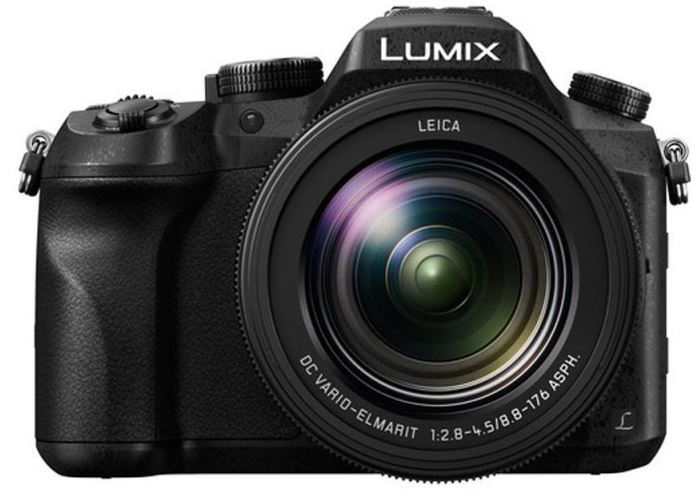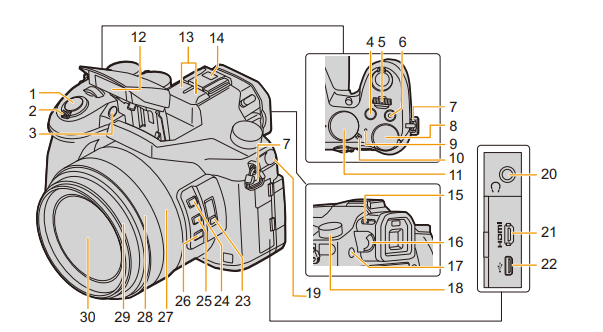
Panasonic LUMIX FZ2500 4K Camera
ABOUT Panasonic
Panasonic Corporation is a multinational electronics company headquartered in Osaka, Japan. It was founded in 1918 by Konosuke Matsushita and originally started as a vendor of duplex lamp sockets. Over the years, Panasonic has grown into one of the largest electronics manufacturers in the world, offering a wide range of products and services.
Panasonic‘s business operations span various sectors, including consumer electronics, home appliances, automotive, industrial solutions, and B2B solutions. The company is known for its innovation and has a strong focus on research and development.
Before Use
Care of the camera
Do not subject to strong vibration, shock, or pressure.
- The lens, monitor, or external case may be damaged if used in the following conditions. It may also malfunction or the image may not be recorded if you:
– Drop or hit the camera.
– Press hard on the lens or the monitor.
Do not hold the lens barrel as you take pictures. There is a risk that your finger will be trapped as the lens retracts.
This camera is not dust/drip/waterproof. Avoid using the camera in places with a lot of dust, water, sand, etc.
- Liquid, sand, and other foreign materials may get into the space around the lens, buttons, etc. Be particularly careful since it may not just cause malfunctions, but it may also become irreparable.
– Places with a lot of sand or dust.
– Places where water can come into contact with this unit, such as when using it on a rainy day or at the beach. If sand, dust, or liquids such as water droplets adhere to the monitor, wipe them off with a dry soft cloth.
– Not doing so may cause the monitor to respond incorrectly to touch operations
– If the monitor is closed when such liquids are present, malfunction may result.
About Condensation (When the lens, the viewfinder, or the monitor is fogged up)
- Condensation occurs when the ambient temperature or humidity changes. Be careful of condensation since it causes lens, viewfinder, and monitor stains, fungus, and camera malfunction.
- If condensation occurs, turn the camera off and leave it for about 2 hours. The fog will disappear naturally when the temperature of the camera becomes close to the ambient temperature.
Standard Accessories
Check that all the accessories are supplied before using the camera.
- The accessories and their shape will differ depending on the country or area where the camera was purchased.
For details on the accessories, refer to “Basic Owner’s Manual”.
- Battery Pack is indicated as battery pack or battery in the text.
- SD Memory Card, SDHC Memory Card, and SDXC Memory Card are indicated as cards in the text.
- The card is optional.
Names and Functions of Components
- Shutter button
- Zoom lever
- Self-timer indicator AF Assist Lamp
- [ ] (Exposure Compensation) button/ [Fn4] button
- Front dial
- Motion picture button
- Shoulder strap eyelet
- Rear dial
- Status indicator / Wi-Fi® connection lamp
- Camera ON/OFF switch
- Mode dial
- Flash
- Stereo microphone
• Be careful not to cover the microphone with your finger. Doing so may make the sound difficult to record. - Hot shoe (Hot shoe cover)
• Keep the Hot Shoe Cover out of reach of children to prevent swallowing. - Flash open lever
- Diopter adjustment dial
- [LVF] button/[Fn7] button
- Drive mode dial
- [MIC] socket
- Headphone socket
- [HDMI] socket
- USB socket
- [ND FILTER] switch
- [Fn1] button
- [Fn2] button ()
- [Fn3] button
- Zoom ring
- Focus ring
- Lens barrel
- Lens surface

- Touch screen /monitor
- Eyecup
- Viewfinder
- Eye sensor
- [AF/AE LOCK] button
- Focus mode lever
- [Q.MENU] (Quick Menu) button / [Fn5] button
- [(] (Playback) button
- [DISP.] button
- 3/[ ] (ISO sensitivity)
1/[ ] (White Balance)
2/[ ] (Auto Focus Mode)
4/[AF#] (AF Macro) - [MENU/SET] button
- [ ] (Delete/Cancel) button / [Fn6] button
- Speaker
- [REMOTE] socket
- Card door
- DC coupler cover
• When using an AC adaptor, ensure that the Panasonic DC coupler (optional) and AC adaptor (optional) are used. - Battery door
- Release lever
- Tripod mount
• It may not be possible to attach and securely fasten a tripod with a screw length of 5.5 mm (0.22 inch) or more to the camera. Doing so may also damage the camera.
∫ About the function button ([Fn8] to [Fn12])
- Function buttons ([Fn8] to [Fn12]) (P55) are touch icons. Touch the [ ] tab on the recording screen to display them.
Getting Started/Basic Operations
Attaching the Lens Hood
In bright sunlight or backlight, the lens hood will minimize lens flare and ghosting. The lens hood cuts off excess lighting and improves the picture quality.
- Do not hold the lens hood in a way that twists or bends it.
- Check that the camera is turned off.
- Close the flash.
- Align the mounting mark under the long side of the lens hood with the mounting projection on the edge of the lens.
A Mounting projection (Lens edge)
B Mounting mark (Lens hood)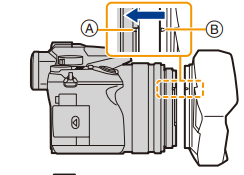
- Screw in the lens hood in the direction of the arrow

- Continue to rotate the lens hood until you hear a “click” even if you feel some stiffness, and then align the mark on the bottom of the camera.

C Rotate until the marks are aligned
- Check that the lens hood is firmly attached and that it does not appear in the picture
- When taking pictures with flash with the lens hood attached, the lower portion of the photo may turn dark (vignetting effect) and the control of the flash may be disabled because the photo flash may be obscured by the lens hood. We recommend detaching the lens hood.
- When temporarily detaching and carrying the lens hood, we recommend attaching it with the orientation reversed. Return it to the normal direction when taking pictures.
- Be careful not to catch your finger, etc. when the lens retracts.
Attaching the Lens Cap
- When you turn the camera off or carry the camera, attach the lens cap to protect the surface of the lens.
- Do not hang or swing around the camera with the lens cap string.
- Make sure to detach the lens cap when turning this unit on.
- Be careful that the lens cap string does not become entangled with the shoulder strap.
- Pass the string through the shoulder strap eyelet (A) on the camera

- Pass the same string through the hole on the lens cap.

- Attach the lens cap.
B: Pinch here to attach or detach the cap.
Attaching the Shoulder Strap
- We recommend attaching the shoulder strap when using the camera to prevent it from dropping.
- Pass the shoulder strap through the shoulder strap eyelet on the camera body.
A: Shoulder strap eyelet
- Pass the end of the shoulder strap through the ring in the direction of the arrow and then pass it through the stopper.

- Pass the end of the shoulder strap through the hole on the other side of the stopper.

- Pull the shoulder strap and then check that it will not come out.
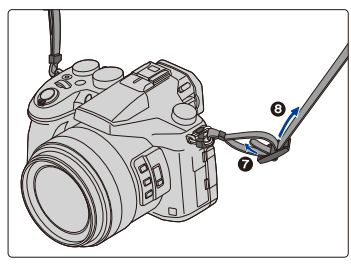
- Perform steps 1 to 4 and then attach the other side of the shoulder strap.
Charging the Battery
About batteries that you can use with this unit
It has been found that counterfeit battery packs which look very similar to the genuine product are made available for purchase in some markets. Some of these battery packs are not adequately protected with internal protection to meet the requirements of appropriate safety standards. There is a possibility that these battery packs may lead to fire or explosion. Please be advised that we are not liable for any accident or failure occurring as a result of the use of a counterfeit battery pack. To ensure that safe products are used, we recommend that a genuine Panasonic battery pack is used.
- Use the dedicated charger and battery.
Charging
- The battery is not charged when the camera is shipped. Charge the battery before use.
- Charge the battery with the charger indoors.
- Attach the battery paying attention to the direction of the battery.

- Connect the charger to the electrical outlet.
The [CHARGE] indicator A lights up and charging begins.
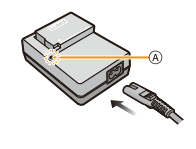
About the [CHARGE] indicator
- On: Charging.
- Off: Charging has been completed. (Disconnect the charger from the electrical socket and detach the battery after charging is completed.)
When the [CHARGE] indicator flashes
- The battery temperature is too high or too low. It is recommended to charge the battery again at an ambient temperature of between 10 C and 30 C (50 oF and 86 oF).
- The terminals of the charger or the battery are dirty. In this case, wipe them with a dry cloth.
Charging time
- Charging time: Approx. 140 min
- The indicated charging time is for when the battery has been discharged completely. The charging time may vary depending on how the battery has been used.
- The charging time for the battery in hot/cold environments or a battery that has not been used for a long time may be longer than normal.
Battery indication
- The indication turns red and blinks if the remaining battery power is exhausted. Tie saus incicator a so olnks.
- Recharge the battery or replace it with a fully charged battery.
- Do not leave any metal items (such as clips) near the contact areas of the power plug. Otherwise. a fire and or electric shocks may be caused by short-circuiting or the resulting accelerated
- The battery can be recharged even when it still has some charge left. but it is not recommended that the battery charge be frequently topped up while the battery is fully charged. Since characteristic swelling may occur.)
Inserting/Removing the Battery
- 1: Slide the release lever in the direction of the arrow (to the OPEN side).
2: Open the battery door.
Always use genuine Panasonic batteries.
If you use other batteries, we cannot guarantee the quality of this product. - Being careful about the battery orientation, insert until you hear a locking sound, and then check that it is locked by lever A. Pull lever A in the direction of the arrow to remove the battery.
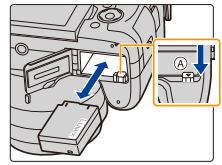
- 1: Close the battery door.
2: Slide the release lever in the direction of the arrow.
- Remove the battery after use. (The battery will be exhausted if left for a long period after being charged.)
- The battery becomes warm after using it and during and after charging. The camera also becomes warm during use. This is not a malfunction.
- Before removing the battery, turn the camera off, and wait until the status indicator has gone off completely.
(Otherwise, this unit may no longer operate normally and the card itself may be damaged or the recorded pictures may be lost.)
Optional accessories
- Some optional accessories may not be available in some countries.
External Flash (optional)
After attaching the flash (DMW-FL200L, DMW-FL360L, DMW-FL580L: optional), the effective range will be increased when compared to the camera’s built-in flash.
Preparations:
- Turn off the camera and close the built-in flash.
- Removing the Hot Shoe Cover The camera comes with a hot shoe cover attached to the hot shoe. Remove the hot shoe cover by pulling it in the direction indicated by arrow 2 while pressing it in the direction indicated by arrow 1

- Keep the Hot Shoe Cover out of reach of children to prevent swallowing.
When using other commercially available external flashes without communication functions with the camera
- It is necessary to set the exposure on the external flash. If you want to use the external flash in Auto Mode, use an external flash that allows you to set the aperture value and the ISO sensitivity to match the settings on the camera.
- Set to Aperture-Priority A Mode or Manual Exposure Mode on the camera and then set the same aperture value and ISO sensitivity on the external flash. (The exposure cannot be compensated adequately due to the change in the aperture value in Shutter-Priority A Mode and the external flash cannot control the light adequately in Program A Mode because the aperture value cannot be fixed.)
- When an external flash is attached, the following functions are available in addition to the functions available with the built-in flash. – Aperture Bracket -Focus Bracket
- You can set the aperture value, the shutter speed, and the ISO sensitivity on the camera even when attaching the external flash.
- If you record at close range with a wide angle, light from the flash may be blocked by the lens, darkening the lower part of the screen.
- Do not use commercially available external flashes with high-voltage synchro terminals. reverse polarity or functions that enable them to communicate with the camera. Doing so may cause the camera to malfunction or operate incorrectly
- When attaching the external flash, do not hold only the external flash because it may detach from the camera.
- Read the operating instructions of the external flash for details
External Microphone (optional)
Using a stereo shotgun microphone (DMW-MS2: optional) or stereo microphone (VW-VMS10: optional), you can record sounds with quality superior to those recorded with the built-in microphone Using the stereo shotgun microphone (DMW-MS2: optional), you can switch between the gun (ultra-directional) recording and the wide range stereo recording.
Preparations:
- + Close the built-in flash, and then turn this unit off.
- Remove the hot shoe cover that is attached to the camera.
Setting the range within which the stereo shotgun microphone (DMW-MS2: optional) will record sounds
- Attach the dedicated stereo shotgun microphone to this unit, and then turn this unit on.
- Select the menu
MENU > [Motion Picture] > [Special Mic.]
- (When [MANUAL] is selected) Press 2/1 to select a range, and press [MENU/SET].
Shutter Remote Control (optional)
If you use the shutter remote control (DMW-RSL1: optional), you can avoid jitter (camera shake) when using a tripod and you can keep the shutter pressed fully when taking pictures with [B] (Bulb) or Burst Mode. The shutter remote control works similar to the shutter button on the camera.
- Always use a genuine Panasonic shutter remote control (DMW-RSL1: optional).
- Record with Creative Video Mode (P168) when using for motion picture recording. Motion picture recording can be started/stopped with the shutter remote control.
- Read the operating instructions of the shutter remote control for details.
Not available in these cases:
- You cannot use the shutter remote control for the following operation.
- – Canceling [Sleep Mode] or [Sleep Mode(Wi-Fi)]
AC adaptor (optional)/DC coupler (optional)
By using the AC adaptor (optional) and DC coupler (optional), you can record and play back without worrying about the remaining battery charge. The optional DC coupler can only be used with the designated Panasonic AC adaptor (optional).
- Always use a genuine Panasonic AC adaptor (optional).
- When using an AC adaptor (optional), use the AC cable supplied with the AC adaptor.
- Also, read the operating instructions for the AC adaptor (optional) and DC coupler.
Filters (optional)
The MC protector is a transparent filter that affects neither the colors nor the amount of light, so it can always be used to protect the camera’s lens. PL filter will suppress the reflected light from metal or nonspherical surfaces (flat non-metallic surfaces, water vapor, or invisible particles in the air), making it possible to take a picture with enhanced contrast.
- Do not attach multiple filters at the same time.
- You can attach the lens cap or the lens hood when the filter is attached.
- Refer to the instructions for each filter for details.
Monitor Display/Viewfinder Display
In recording


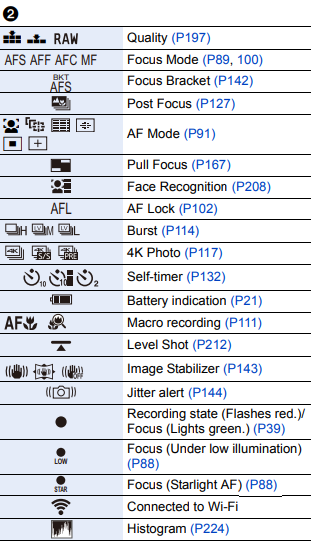
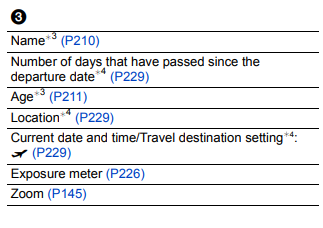
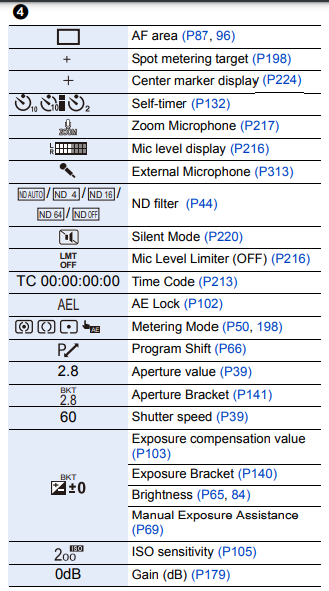


- This is displayed only when [Video-Priority Display] (P227) in the [Custom] menu is set to [ON].
- h: hour, m: minute, s: second
- This is displayed for about 5 seconds when the camera is turned on if the [Profile Setup] setting is set.
- This is displayed for about 5 seconds when the camera is turned on, after setting the clock, and after switching from Playback Mode to Recording Mode.
On-monitor recording information
In recording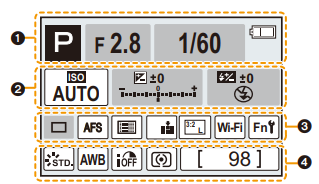

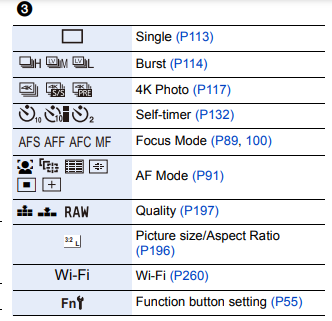
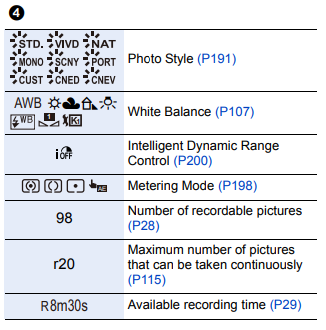
On-monitor recording information ([Video-Priority Display])
In recording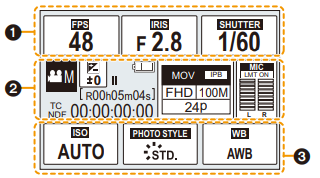

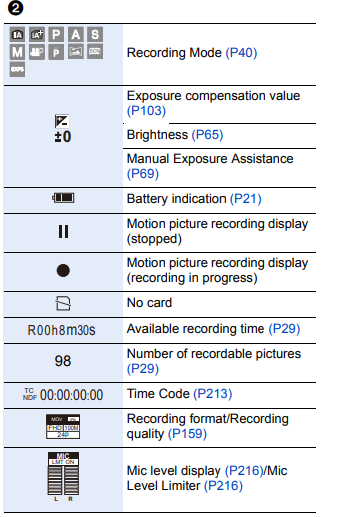

In playback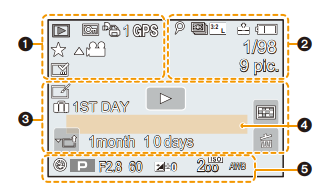



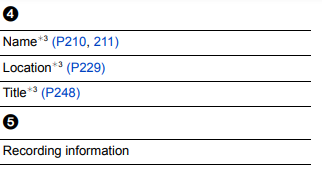
Detailed information display
In playback


Histogram display
In playback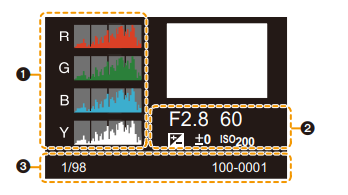

- h: hour, m: minute, s: second
- This is displayed only when [Video-Priority Display] (P227) in the [Custom] menu is set to [ON].
- It is displayed in order of [Title], [Location], [Name] ([Baby1]/[Baby2], [Pet]), [Name] ([Face Recog.]).
Troubleshooting
First, try out the following procedures (P327 to P335).
If the problem is not resolved, it may be improved by selecting [Reset] (P235) on the [Setup] menu.
Battery and power source
- The camera cannot be operated even when it is turned on.
The camera turns off immediately after it is turned on. - The battery is exhausted. Charge the battery. (P20)
This unit is turned off automatically.
- [Economy] is enabled. (P232)
The battery becomes flat too quickly.
- When [ ] ([4K Pre-Burst]) is set, the battery drains faster.
- > Select [ ] ([4K Pre-Burst]) only when recording.
- Is a Wi-Fi connection being used for a long period?
The battery can become flat quickly when connected to Wi-Fi. - > Turn the camera off frequently by using the [Economy] etc. (P232)
Recording
Taking pictures is not possible. The shutter will not operate immediately when the shutter button is pressed.
- Is [Focus/Release Priority] in the [Custom] menu set to [FOCUS]? (P222) You cannot take a picture until the subject is brought into focus.
The recorded picture is whitish.
- The picture might look whitish when the lens gets dirty with fingerprints or similar. If the lens is dirty turn the camera off and then gently wipe the lens surface with a soft, dry cloth.
The recorded picture is too bright or dark.
- Is the AE Lock (P102) applied incorrectly?
Multiple pictures are taken at one time.
- Check the drive mode setting. (P113)
- Are you using the bracket function? (P139)
The subject is not focused properly.
- The subject is beyond the focus range of the camera.
- Is [Focus/Release Priority] in the [Custom] menu set to [RELEASE]? (P222) Is [Shutter AF] in the [Custom] menu set to [OFF]? (P220)
- Is the AF Lock (P102) applied incorrectly?
The recorded picture is blurred. The Image Stabilizer is not effective.
- The shutter speed will become slower and the Image Stabilizer function may not work properly when taking pictures, especially in dark places.
- We recommend using a tripod and the self-timer (P132) when taking pictures with a slow shutter speed.
The recorded picture looks rough. Noise appears in the picture.
- Try the following:
- > Decrease the ISO sensitivity. (P105)
- > Increase the setting for [Noise Reduction] in [Photo Style] or lower the setting for each of the items other than [Noise Reduction]. (P192) > Set the [Long Shtr NR] to [ON]. (P206)
The subject appears distorted in the picture.
- If you record a moving subject when using the electronic shutter or recording a motion picture or a 4K photo, the subject may appear distorted in the picture. This is characteristic of MOS sensors which serve as the camera’s pickup sensors. This is not a malfunction.
Striping or flicker may appear under lighting such as fluorescent lighting and LED lighting fixtures.
- This is characteristic of MOS sensors which serve as the camera’s pickup sensors. This is not a malfunction.
- When using the electronic shutter (P204), lowering the shutter speed may reduce the effect of the horizontal stripes.
- If noticeable flicker or striping is seen under lighting such as a fluorescent or LED lighting fixture when recording motion pictures, you can reduce the flicker or striping by setting up [Flkr Decrease] (P215) and fixing the shutter speed. It is possible to select a shutter speed from [1/50], [1/60], [1/100], or [1/120]. You can set the shutter speed manually in the Creative Video Mode. (P168)
The brightness or the hue of the recorded picture is different from the actual scene.
- When recording under fluorescent or LED lighting fixtures, etc., increasing the shutter speed may introduce slight changes to brightness and color. These are a result of the characteristics of the light source and do not indicate a malfunction.
- When recording subjects in extremely bright locations or recording under fluorescent lighting, LED lighting fixtures, mercury lamps, sodium lighting, etc., the colors and screen brightness may change or horizontal striping may appear on the screen.
Motion pictures
Recording motion pictures is not possible.
- If you continue to use the same card after changing [System Frequency] (P236), motion pictures may not be recorded. To record with the same card, reset [System Frequency] to the original setting. To record motion pictures with the current setting, try the following: > Perform formatting (P28) on this unit after saving necessary data on a PC, etc. > Insert a different card.
- You may not be able to record for a short while after turning this unit on when using a large-capacity card.
Motion picture recording stops in the middle.
- Depending on the [Rec Format] and [Rec Quality] of a motion picture, the speed class rating required for the card differs. Use a card that meets the rating. (“About motion picture/4K photo recording and speed class ratings” on P26)
Sometimes it is difficult to focus with Auto Focus when recording 4K motion pictures.
- This phenomenon occurs when the camera is trying to record with highly accurate focus at a reduced Auto Focus speed, and is not a malfunction.
In motion pictures, abnormal clicking and buzzing sounds are recorded. The recorded sound is very quiet.
- When recording in a quiet environment, the sound of aperture, focus, or zoom operation may be recorded in motion pictures. Focus operation can be set to [OFF] in [Continuous AF] (P163).
- While recording motion pictures, plugging the aperture of the microphone with a finger may reduce the level of audio recording or audio may not record at all. Also, be careful because the operation sound of lenses can easily be recorded at this time.
An operation sound is recorded in a motion picture.
- Use of [Silent Operation] is recommended if you are concerned about operational sounds. (P176)
Flash
The flash is not activated.
- Is the flash closed? Open the flash. (P148)
- When the electronic shutter is used, the flash is not activated. (P204)
- When [Silent Mode] is set to [ON], the flash is not activated. (P220)
Monitor/Viewfinder
The Monitor/Viewfinder turns off although the camera is turned on.
- If no operations are performed during the set period, [Auto LVF/Monitor Off] (P232) is activated, and the Monitor/Viewfinder turns off.
- When an object or your hand is positioned near the eye sensor, the Monitor display may switch to the Viewfinder display. (P37)
It may flicker for an instant or the brightness of the screen may change significantly for an instant.
- This occurs due to the aperture of the lens changing when the shutter button is pressed halfway, or when the brightness of the subject changes. This is not a malfunction.
The monitor and viewfinder do not switch when [LVF] is pressed.
- It is only displayed on the monitor when the camera is connected to a PC or printer.
Unevenly bright parts or irregular colors appear on the Viewfinder.
- The viewfinder of this unit adopts OLED. Screen burn-in may occur on the screen/viewfinder when the same image is displayed for a long period, but it does not affect the recorded images.
The color tone of the viewfinder differs from the actual tone.
- Being a characteristic of the viewfinder of this unit, this phenomenon is not a problem. Recorded images are not affected.
Playback
The picture is not played back. There are no recorded pictures.
- Is the card inserted?
- Is this a folder or picture that was processed on the PC?
- If it is, it cannot be played back by this unit.
- > It is recommended to use the software “PHOTOfunSTUDIO” (P304) to write pictures from PC to card.
- Has [Playback Mode] been set for playback?
- > Change to [Normal Play]. (P240)
Cannot play back motion pictures.
- Motion pictures recorded with a different [System Frequency] setting cannot be played back. (P236)
- > Return the [System Frequency] setting to the one you used during the recording.
The red part of the recorded image has changed color to black.
- When Red-Eye Removal ([ ] or [ ]) is performed, red parts may be corrected to black. > It is recommended to take pictures with the flash closed, Flash Mode set to [‰], or [Red-Eye Removal] set to [OFF]. (P205)
Wi-Fi function
A Wi-Fi connection cannot be established. Radio waves get disconnected. The wireless access point is not displayed.
∫ General tips for using a Wi-Fi connection
- Use within the communication range of the device to be connected.
- Is any device, such as a microwave oven, cordless phone, etc., that uses 2.4 GHz frequency operated nearby?
- > Radio waves may get interrupted when used simultaneously. Use them sufficiently away from the device.
- When the battery indicator is flashing red, the connection with other equipment may not start or the connection may be disrupted.
(A message such as [Communication error] is displayed.)
- If you place the camera on a metal table or shelf, the radio waves may be adversely affected. In such cases, you may not be able to establish a connection. Move the camera away from the metal surface.
∫ About a wireless access point
- Check if the wireless access point to connect is operating.
- Check the radio wave condition of the wireless access point.> Move this unit closer to the wireless access point.
- > Change the location and orientation of the wireless access point.
- It may not display even if the radio waves exist depending on the setting of the wireless access point.
- > Turn off and on the wireless access point.
- > Check the settings of the wireless access point.
- > When the network SSID of the wireless access point is set not to broadcast, the wireless access point may not be detected. Enter the network SSID to start the connection (P292) or enable the SSID broadcast of the wireless access point.
This unit is not displayed on the Wi-Fi setting screen of the smartphone.
- From the Wi-Fi setting menu on the smartphone, turn off and then on the Wi-Fi function.
When I try to set up a Wi-Fi connection with a Windows 8 PC, my username and password are not recognized, so I cannot connect to the PC.
- Some OS versions, including Windows 8, use two types of accounts: a local account and a Microsoft account.
- Be sure to use the username and password for the local account.
The PC is not recognized when I use a Wi-Fi connection. The camera cannot be connected to a PC via a Wi-Fi connection.
- The default workgroup name is set to “WORKGROUP”. If you change the workgroup name, the PC will not be recognized.
- In [Change Workgroup Name] in [PC Connection] of the [Wi-Fi Setup] menu, change the workgroup name to that of the PC you are connecting to. (P296)
- Please confirm login name and password are correctly typed.
- When the system time of a Mac computer or Windows PC connected to a camera differs severely from that of the camera, the camera cannot be connected to the computer or PC in some OSs.
- > Please confirm that [Clock Set] and [World Time] of the camera match with the time, date, and time zone on a Windows PC or Mac computer. When both settings do not match severely, please match them.
Images cannot be transmitted to the web service.
- Confirm that the login information (login ID/user name/email address/password) is correct.
It takes time to transmit an image to the web service. Transmission of the image fails midway. Some images cannot be transmitted.
- Is the size of the image too large?
- > Reduce the image size at [Size] (P275), and then send.
- > Transmit after dividing the motion picture with [Video Divide] (P250).
- It may take a longer time to transmit when the distance to the wireless access point is far.> Transmit closer to the wireless access point.
- The file format of the motion picture that can be sent differs depending on the destination. (P273)
I have forgotten the password for the Wi-Fi.
- Execute the [Reset Wi-Fi Settings] in the [Setup] menu. (P235)
However, all the information you have set on the [Wi-Fi Setup] menu will be reset. (excluding [LUMIX CLUB])
TV, PC, and printer
The picture does not appear on the television.
- Is the camera connected to the TV correctly? (P300) > Set the TV input to external input mode.
VIERA Link does not work.
- Is the [VIERA Link] on this unit set to [ON]? (P234) > Check the VIERA Link setting on the connected device.
- > Turn this unit off and on.
- > Check [System Frequency] setting. (P236)
Cannot communicate with the PC.
- Set to [PC] in [USB Mode]. (P232, 306)
- Turn this unit off and on.
The card is not recognized by the PC. (SDXC memory card is used.)
Check if your PC is compatible with SDXC memory cards.
http://panasonic.net/avc/sdcard/information/SDXC.html
- A message prompting to format the card may be displayed when connecting, but do not format.
- If the [Access] displayed on the monitor does not disappear, disconnect the USB connection cable after turning this unit off.
The picture cannot be printed when the camera is connected to a printer.
- Pictures cannot be printed using a printer that does not support PictBridge.
- > Set to [PictBridge(PTP)] in [USB Mode]. (P232, 309)
The ends of the pictures are cut at printing.
- When using a printer with a Cropping or borderless printing function, cancel this function before printing.
(For details, refer to the operating instructions for the printer.)
- When you order photo studios to print pictures, ask the photo studio if the 16:9 pictures can be printed.
Others
There is a sound from the lens unit.
- It is a sound of lens movement or aperture operation when this unit is turned on or off, and it is not a malfunction.
- The sound, which is caused by the automatic adjustment of the aperture, is heard when the brightness has changed due to, for example, zooming or the movement of the camera. This is not a malfunction.
Zooming stops instantaneously.
- When using the Extended Optical Zoom, the zooming action will stop temporarily. This is not a malfunction.
An unreadable language was selected by mistake.
- Press [MENU/SET], select the [Setup] menu icon [], and then select the [~] icon to set the desired language. (P234)
A red lamp sometimes turns on when the shutter button is pressed halfway.
- In dark places, the AF Assist Lamp (P221) lights red to make it easier to focus on a subject.
The camera becomes warm.
- The surface of the camera and the reverse side of the monitor may become warm during use. This does not affect the performance or quality of the camera.
The clock is reset.
- If you do not use the camera for a long time, the clock may be reset.
- > [Please set the clock] message will be displayed; please reset the clock. (P33)
Cautions for Use
Keep this unit as far away as possible from electromagnetic equipment (such as microwave ovens, TVs, video games etc.).
- If you use this unit on top of or near a TV, the pictures and/or sound on this unit may be disrupted by electromagnetic wave radiation.
- Do not use this unit near cell phones because doing so may result in noise adversely affecting the pictures and/or sound.
- Recorded data may be damaged, or pictures may be distorted, by strong magnetic fields created by speakers or large motors.
- Electromagnetic wave radiation may adversely affect this unit, disturbing the pictures and/or sound.
- If this unit is adversely affected by electromagnetic equipment and stops functioning properly, turn this unit off and remove the battery or disconnect the AC adaptor (optional). Then reinsert the battery or reconnect the AC adaptor and turn this unit on.
Do not use this unit near radio transmitters or high-voltage lines.
- If you record near radio transmitters or high-voltage lines, the recorded pictures and/or sound may be adversely affected.
Always use the supplied cords and cables.
If you use optional accessories, use the cords and the cables supplied with them. Do not extend the cords or the cables.
Do not spray the camera with insecticides or volatile chemicals.
- If the camera is sprayed with such chemicals, the body of the camera may be damaged and the surface finish may peel off.
Do not keep rubber or plastic products in contact with the camera for a long period.
Keep objects sensitive to magnetic fields (credit cards, etc.) away from the camera.
Otherwise, magnetic fields may damage their data and make them unusable.
Cleaning
Before cleaning the camera, remove the battery or the DC coupler (optional), or disconnect the power plug from the outlet. Then wipe the camera with a dry, soft cloth.
- When the camera is soiled badly, it can be cleaned by wiping the dirt off with a wrung wet cloth, and then with a dry cloth.
- Do not use solvents such as benzine, thinner, alcohol, kitchen detergents, etc., to clean the camera, since it may deteriorate the external case or the coating may peel off.
- When using a chemical cloth, be sure to follow the accompanying instructions.
∫ For care of the viewfinder/Eyecup
- As the eye cup cannot be removed, blow away the dust on the viewfinder surface with a blower (commercially available), gently wipe it with a dry and soft cloth, and be careful not to remove it.
- If you wipe the eye cup too hard and it is removed, consult the dealer or Panasonic.
About the Monitor/Viewfinder
- Do not press the monitor with excessive force. Uneven colors may appear on the monitor and it may malfunction.
- If the camera is cold when you turn it on, the picture on the Monitor/Viewfinder will be slightly darker than usual at first. However, the picture will return to normal brightness when the internal temperature of the camera increases.
- Do not press the lens with excessive force.
- Do not leave the camera with the lens facing the sun as rays of light from the sun may cause it to malfunction. Also, be careful when placing the camera outside or near a window.
- When there is dirt (water, oil, and fingerprints, etc.) on the surface of the lens, the picture may be affected. Lightly wipe the surface of the lens with a soft, dry cloth before and after taking pictures.
- Retract the lens when carrying the camera.
FAQS About Panasonic LUMIX FZ2500 4K Camera
The Lumix FZ2500 is weatherproof.
Yes
What distinguishes Lumix cameras?
There is a wonderful selection of cameras from Panasonic Lumix. The Micro Four Thirds cameras are their specialty.
What is the Lumix FZ2500’s crop factor?
Both add a crop factor while recording 4K video, although the Panasonic’s crop is 1.43 times larger than the Sony’s crop, which is 1.09 times larger.
What is the Lumix FZ2500’s battery life?
350 shots
What is the FZ2500’s shutter speed?
Mechanical – 60 to 1/4000 sec.; 1 to 1/16, 000 sec.
A FZ2500 thread is what size?
The lens’s filter threads are 67mm.
The Panasonic FZ2500 was released when?
28 November 2016.
What is the charging time for a Lumix?
roughly 2–3 hours
What shutter speed is appropriate?
Your shutter speed must be twice as fast as your lens’s focal length, if not faster.
Which shutter speed is the highest?
A thousandth of a second
For more manuals by Panasonic, Visit Manualsdock
[embeddoc url=”https://manualsdock.com/wp-content/uploads/2023/09/Panasonic-LUMIX-FZ2500-4K-Camera-Owner-Manual.pdf” download=”all”]


